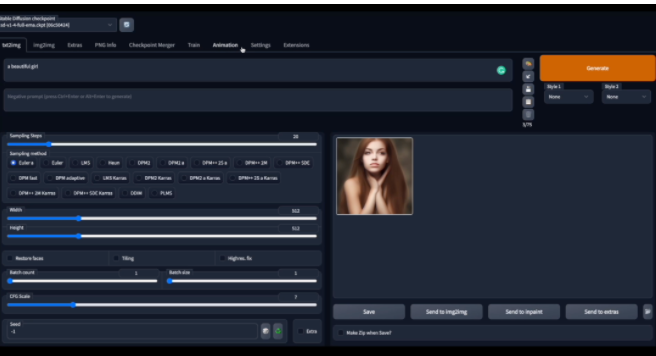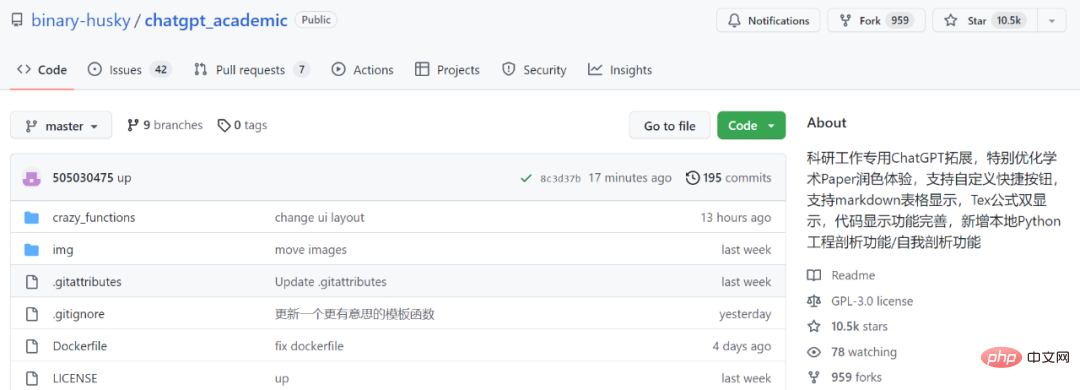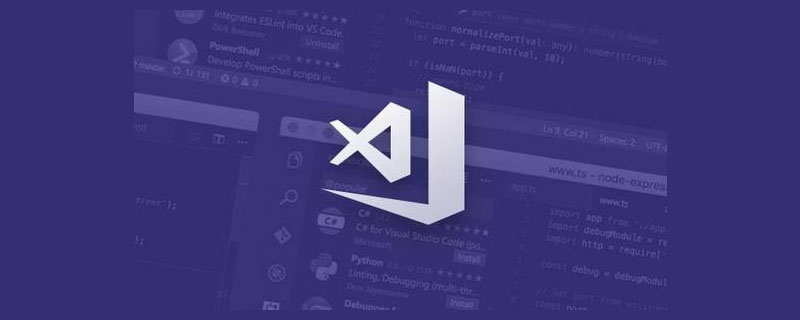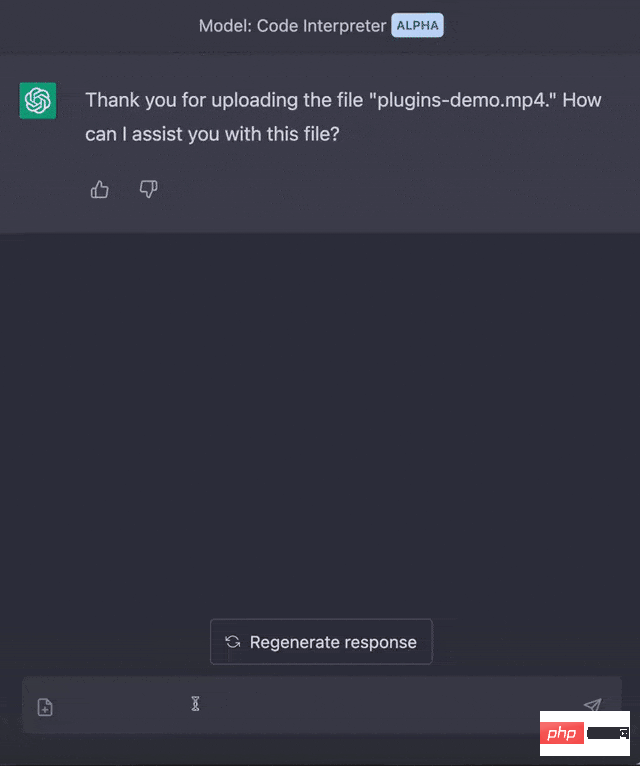This article brings you relevant knowledge about PHP. It mainly introduces how I use ChatGPT to learn the implementation of AOP in PHP. Friends who are interested can take a look below. I hope it will be helpful to everyone.

In PHP, there are two main ways to implement AOP: static AOP based on proxy mode and dynamic AOP based on hook functions. The main ideas and sample codes of these two implementation methods are introduced below:
1. Static AOP based on proxy mode: Static AOP compiles the cross-cutting processing logic into the bytecode of the target class, and when the program is running The generation of proxy objects can be completed beforehand, so that the behavior of the class can be dynamically added or modified without modifying the original code. Static AOP requires a specific compiler or extension.
The sample code is as follows:
// 定义一个代理类,用于代表目标类并增强其行为
class LogProxy {
private $target; // 目标类的实例
public function __construct($target) {
$this->target = $target;
}
public function foo() {
echo "before calling foo()\n";
$result = $this->target->foo();
echo "after calling foo()\n";
return $result;
}
}
// 定义一个目标类
class Foo {
public function foo() {
echo "executing foo()\n";
}
}
// 编译期间使用代理类替换目标类,并返回代理类的实例
function compile($className) {
$code = file_get_contents("$className.php");
$code = str_replace("class $className", "class ${className}_proxy extends $className", $code);
$code .= "\n\nnew ${className}_proxy();";
eval($code);
return new ${className}_proxy(new $className());
}
// 使用静态AOP增强Foo类的行为
$foo = compile('Foo');
$foo->foo(); // output: before calling foo() executing foo() after calling foo()The above code demonstrates how to generate a proxy class during compilation through the proxy mode and dynamically enhance the behavior of the target class at runtime. In this example, we define a LogProxy class to represent the Foo class and add logging logic to it. Then use the compile() function to replace the Foo class with the Foo_proxy class and return an instance of the proxy class. Finally, the foo () method of the target class is executed by calling the foo () method of the proxy class, and the corresponding cross-cutting processing logic is added before and after it.
2. Dynamic AOP based on hook functions: Dynamic AOP dynamically generates proxy objects and weaves in cross-cutting processing logic when the program is running. It can be implemented through PHP's magic methods, reflection and anonymous functions. Among them, the proxy object can insert corresponding cross-cutting processing logic at various times before, after, method execution, exception, return, etc., to implement functions such as logging, performance statistics, and transaction management.
The sample code is as follows:
// 定义一个目标类
class Foo {
public function foo() {
echo "executing foo()\n";
}
}
// 定义一个AOP代理类,用于动态织入横切处理逻辑
class AopProxy {
private $target; // 目标类的实例
public function __construct($target) {
$this->target = $target;
}
// 在目标方法前插入日志记录的逻辑
public function before() {
echo "before calling foo()\n";
}
// 在目标方法后插入日志记录的逻辑
public function after() {
echo "after calling foo()\n";
}
// 在目标方法出现异常时插入异常处理的逻辑
public function exception($exception) {
echo "exception occurred: " . $exception->getMessage() . "\n";
}
// 在目标方法返回结果时插入结果处理的逻辑
public function return($result) {
echo "returned result: " . $result . "\n";
}
// 动态生成代理对象,并织入横切处理逻辑
public static function proxy($target, $aspect) {
$proxy = new self($target);
return new class($proxy, $aspect) extends \ReflectionClass {
private $proxy;
private $aspect;
public function __construct($proxy, $aspect) {
parent::__construct($proxy);
$this->proxy = $proxy;
$this->aspect = $aspect;
}
public function __call($name, $args) {
if (!method_exists($this->proxy->target, $name)) {
throw new \BadMethodCallException("Method $name not exists");
}
$this->aspect->before();
try {
$result = parent::__call($name, $args);
$this->aspect->return($result);
} catch (\Throwable $e) {
$this->aspect->exception($e);
throw $e;
} finally {
$this->aspect->after();
}
return $result;
}
};
}
}
// 使用动态AOP增强Foo类的行为
$foo = new Foo();
$proxy = AopProxy::proxy($foo, new AopProxy());
$proxy->foo(); // output: before calling foo() executing foo() returned result: after calling foo()The above code demonstrates how to dynamically generate a proxy object at runtime through dynamic proxy and reflection, and insert corresponding cross-cutting processing logic before and after its method call. In this example, we define an AopProxy class to represent the target class Foo, and add logic such as logging, exception handling, and result processing to it. Then use the proxy () method to convert the Foo instance into a proxy object, passing in the AopProxy instance as a parameter. Finally, the foo () method of the target class is executed by calling the foo () method of the proxy object, and the corresponding cross-cutting processing logic is added before and after it.
Recommended learning: "PHP Video Tutorial"
The above is the detailed content of ChatGPT taught me how to implement AOP in PHP (with code). For more information, please follow other related articles on the PHP Chinese website!
 令人惊艳的4个ChatGPT项目,开源了!Mar 30, 2023 pm 02:11 PM
令人惊艳的4个ChatGPT项目,开源了!Mar 30, 2023 pm 02:11 PM自从 ChatGPT、Stable Diffusion 发布以来,各种相关开源项目百花齐放,着实让人应接不暇。今天,着重挑选几个优质的开源项目分享给大家,对我们的日常工作、学习生活,都会有很大的帮助。
 Word文档拆分后的子文档字体格式变了怎么办Feb 07, 2023 am 11:40 AM
Word文档拆分后的子文档字体格式变了怎么办Feb 07, 2023 am 11:40 AMWord文档拆分后的子文档字体格式变了的解决办法:1、在大纲模式拆分文档前,先选中正文内容创建一个新的样式,给样式取一个与众不同的名字;2、选中第二段正文内容,通过选择相似文本的功能将剩余正文内容全部设置为新建样式格式;3、进入大纲模式进行文档拆分,操作完成后打开子文档,正文字体格式就是拆分前新建的样式内容。
 学术专用版ChatGPT火了,一键完成论文润色、代码解释、报告生成Apr 04, 2023 pm 01:05 PM
学术专用版ChatGPT火了,一键完成论文润色、代码解释、报告生成Apr 04, 2023 pm 01:05 PM用 ChatGPT 辅助写论文这件事,越来越靠谱了。 ChatGPT 发布以来,各个领域的从业者都在探索 ChatGPT 的应用前景,挖掘它的潜力。其中,学术文本的理解与编辑是一种极具挑战性的应用场景,因为学术文本需要较高的专业性、严谨性等,有时还需要处理公式、代码、图谱等特殊的内容格式。现在,一个名为「ChatGPT 学术优化(chatgpt_academic)」的新项目在 GitHub 上爆火,上线几天就在 GitHub 上狂揽上万 Star。项目地址:https://github.com/
 30行Python代码就可以调用ChatGPT API总结论文的主要内容Apr 04, 2023 pm 12:05 PM
30行Python代码就可以调用ChatGPT API总结论文的主要内容Apr 04, 2023 pm 12:05 PM阅读论文可以说是我们的日常工作之一,论文的数量太多,我们如何快速阅读归纳呢?自从ChatGPT出现以后,有很多阅读论文的服务可以使用。其实使用ChatGPT API非常简单,我们只用30行python代码就可以在本地搭建一个自己的应用。 阅读论文可以说是我们的日常工作之一,论文的数量太多,我们如何快速阅读归纳呢?自从ChatGPT出现以后,有很多阅读论文的服务可以使用。其实使用ChatGPT API非常简单,我们只用30行python代码就可以在本地搭建一个自己的应用。使用 Python 和 C
 vscode配置中文插件,带你无需注册体验ChatGPT!Dec 16, 2022 pm 07:51 PM
vscode配置中文插件,带你无需注册体验ChatGPT!Dec 16, 2022 pm 07:51 PM面对一夜爆火的 ChatGPT ,我最终也没抵得住诱惑,决定体验一下,不过这玩意要注册需要外国手机号以及科学上网,将许多人拦在门外,本篇博客将体验当下爆火的 ChatGPT 以及无需注册和科学上网,拿来即用的 ChatGPT 使用攻略,快来试试吧!
 用ChatGPT秒建大模型!OpenAI全新插件杀疯了,接入代码解释器一键getApr 04, 2023 am 11:30 AM
用ChatGPT秒建大模型!OpenAI全新插件杀疯了,接入代码解释器一键getApr 04, 2023 am 11:30 AMChatGPT可以联网后,OpenAI还火速介绍了一款代码生成器,在这个插件的加持下,ChatGPT甚至可以自己生成机器学习模型了。 上周五,OpenAI刚刚宣布了惊爆的消息,ChatGPT可以联网,接入第三方插件了!而除了第三方插件,OpenAI也介绍了一款自家的插件「代码解释器」,并给出了几个特别的用例:解决定量和定性的数学问题;进行数据分析和可视化;快速转换文件格式。此外,Greg Brockman演示了ChatGPT还可以对上传视频文件进行处理。而一位叫Andrew Mayne的畅销作
 ChatGPT教我学习PHP中AOP的实现(附代码)Mar 30, 2023 am 10:45 AM
ChatGPT教我学习PHP中AOP的实现(附代码)Mar 30, 2023 am 10:45 AM本篇文章给大家带来了关于php的相关知识,其中主要介绍了我是怎么用ChatGPT学习PHP中AOP的实现,感兴趣的朋友下面一起来看一下吧,希望对大家有帮助。


Hot AI Tools

Undresser.AI Undress
AI-powered app for creating realistic nude photos

AI Clothes Remover
Online AI tool for removing clothes from photos.

Undress AI Tool
Undress images for free

Clothoff.io
AI clothes remover

AI Hentai Generator
Generate AI Hentai for free.

Hot Article

Hot Tools

Dreamweaver CS6
Visual web development tools

DVWA
Damn Vulnerable Web App (DVWA) is a PHP/MySQL web application that is very vulnerable. Its main goals are to be an aid for security professionals to test their skills and tools in a legal environment, to help web developers better understand the process of securing web applications, and to help teachers/students teach/learn in a classroom environment Web application security. The goal of DVWA is to practice some of the most common web vulnerabilities through a simple and straightforward interface, with varying degrees of difficulty. Please note that this software

WebStorm Mac version
Useful JavaScript development tools

Atom editor mac version download
The most popular open source editor

MinGW - Minimalist GNU for Windows
This project is in the process of being migrated to osdn.net/projects/mingw, you can continue to follow us there. MinGW: A native Windows port of the GNU Compiler Collection (GCC), freely distributable import libraries and header files for building native Windows applications; includes extensions to the MSVC runtime to support C99 functionality. All MinGW software can run on 64-bit Windows platforms.







